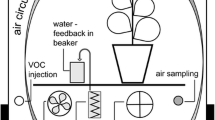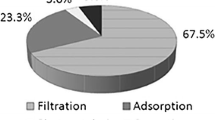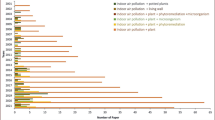Abstract
Indoor air purification received more attention recently. In this study, the effects of six common indoor ornamental plants (Epripremnum aureum, Chlorphytum comosum, Aloe vera, Sedum sediforme, Cereus cv. Fairy Castle, and Sedum adolphii) and three kinds of microalgae (Chlorella sp. HQ, Scenedesmus sp. LX1, and C. vulgaris) on the removal of four types of air pollutants (particulate matters less than 2.5 (PM2.5) and 10 μm (PM10) in size, formaldehyde (HCHO) and total volatile organic compounds (VOCS)) in test chamber compared with common physical purification methods (high efficiency particulate air filter and nano activated carbon absorption) were investigated. Their effects on oxygen, carbon dioxide, and relative humidity were also evaluated. The results showed that microalgae, especially C. vulgaris, was more suitable for removing PM2.5 and PM10, and the removal rates were 55.42 ± 25.77% and 45.76 ± 5.32%, respectively. The removal rates of HCHO and VOCs by all three kings of microalgae could reach 100%. Part of ornamental plants took a longer time to achieve 100% removal of HCHO and VOCs. Physical methods were weaker than ornamental plants and microalgae in terms of increased relative humidity and O2 content. In general, microalgae, especially C. vulgaris could purify indoor air pollutants more efficiently. The above studies provided data and theoretical support for the purification of indoor air pollutants by microalgae.






Similar content being viewed by others
Data availability
The datasets generated during and/or analyzed during the current study are available in the manuscript.
Abbreviations
- PM2.5 :
-
Particulate matters less than 2.5
- PM10 :
-
Particulate matters less than 10
- HCHO:
-
Formaldehyde
- VOCs:
-
Total volatile organic compounds
- HEPA:
-
High-efficiency particulate air filter
- NAC:
-
Nano activated carbon absorption
References
Aydogan A, Montoya LD (2011) Formaldehyde removal by common indoor plant species and various growing media. Atmos Environ 45:2675–2682. https://doi.org/10.1016/j.atmosenv.2011.02.062
Barn P, Gombojav E, Ochir C, Laagan B, Beejin B, Naidan G, Boldbaatar B, Galsuren J, Byambaa T, Janes C, Janssen PA, Lanphear BP, Takaro TK, Venners SA, Webster GM, Yuchi W, Palmer CD, Parsons PJ, Roh YM, Allen RW (2018) The effect of portable HEPA filter air cleaners on indoor PM2.5 concentrations and second hand tobacco smoke exposure among pregnant women in Ulaanbaatar, Mongolia: The UGAAR randomized controlled trial. Sci Total Environ 615:1379–1389. https://doi.org/10.1016/j.scitotenv.2017.09.291
Beatty TKM, Shimshack JP (2014) Air pollution and children's respiratory health: a cohort analysis. J Environ Econ Manage 67:39–57. https://doi.org/10.1016/j.jeem.2013.10.002
Bertol CD, Vieira KP, Rossato LG, Avila JVD (2012) Microbiological environmental monitoring after the use of air purifier ozone generator. Ozone Sci Eng 34:225–230. https://doi.org/10.1080/01919512.2012.679871
Cao Y, Li F, Wang Y, Yu Y, Wang Z, Liu X, Ding K (2019) Assisted deposition of PM2.5 from indoor air by ornamental potted plants. Sustainability 11. https://doi.org/10.3390/su11092546
Chai WS, Chew CH, Munawaroh HSH, Ashokkumar V, Cheng CK, Park Y, Show PL (2021a) Microalgae and ammonia: a review on inter-relationship. Fuel 303:121303. https://doi.org/10.1016/j.envpol.2020.116236
Chai WS, Tan WG, Munawaroh HS, Gupta VK, Ho SH, Show PL (2021b) Multifaceted roles of microalgae in the application of wastewater biotreatment: a review. Environmental Pollution 269:116236. https://doi.org/10.1016/j.fuel.2021.121303
Cheah WY, Ling TC, Juan JC, Lee DJ, Chang JS, Show PL (2016) Biorefineries of carbon dioxide: from carbon capture and storage (CCS) to bioenergies production. Bioresour Technol 215:346–356. https://doi.org/10.1016/j.biortech.2016.04.019
Cheng DJ, Li XY, Yuan YZ, Zhao Q (2019) Kinetic model for effects of simulated flue gas onto growth profiles of Chlorella sp. AE10 and Chlorella sp. Cv. Biotechnol Appl Biochem 67(5):783–789. https://doi.org/10.1002/bab.1829
Chisti Y (2007) Biodiesel from microalgae. Biotechnol Adv 25:294–306. https://doi.org/10.1016/j.biotechadv.2007.02.001
Daugaard S, Markvart J, Bonde JP, Christoffersen J, Garde AH, Hansen ÅM, Schlünssen V, Vestergaard JM, Vistisen HT, Kolstad HA (2019) Light exposure during days with night, outdoor, and indoor work. Ann Work Expo Health 63(6):651–665. https://doi.org/10.1093/annweh/wxy110
Ding Y, Xu C, Luo SL, Hao ZP (2016) Comparison of five succulent plants' formaldehyde removing ability. Chinese Hortlculture abstracts 32:17–20
Gao JH, Woodward A, Vardoulakis S, Kovats S, Wilkinson P, Li LP, Xu L, Li J, Yang J, Li J, Cao LN, Liu XB, Wu HX, Liu QY (2017) Haze, public health and mitigation measures in China: a review of the current evidence for further policy response. Sci Total Environ 578:148–157. https://doi.org/10.1016/j.scitotenv.2016.10.231
Gawronska H, Bakera B (2015) Phytoremediation of particulate matter from indoor air by Chlorophytum comosum L. plants. Air Qual Atmos Health 8:265–272. https://doi.org/10.1007/s11869-014-0285-4
Gong Y, Zhou T, Wang PR, Lin YN, Zheng RM, Zhao YC, Xu B (2019) Fundamentals of ornamental plants in removing benzene in indoor Air. Atmosphere 10. https://doi.org/10.3390/atmos10040221
Han Y, Qi M, Chen YL, Shen HZ, Liu J, Huang Y, Chen H, Liu WX, Wang XL, Liu JF, Xing BS, Tao S (2015) Influences of ambient air PM2.5 concentration and meteorological condition on the indoor PM2.5 concentrations in a residential apartment in Beijing using a new approach. Environ Pollut 205:307–314. https://doi.org/10.1016/j.envpol.2015.04.026
Hubbard HF, Coleman BK, Sarwar G, Corsi RL (2005) Effects of an ozone-generating air purifier on indoor secondary particles in three residential dwellings. Indoor Air 15:432–444. https://doi.org/10.1111/j.1600-0668.2005.00388.x
Kim S, Lee S, Hwang K, An K (2017) Exploring sustainable street tree planting patterns to be resistant against fine particles (PM2.5). Sustainability 9:1709. https://doi.org/10.3390/su9101709
Klinthong W, Yang Y, Huang C, Tan C (2015) A review: microalgae and their applications in CO2 capture and renewable energy. Aerosol Air Qual Res 15(2):712–742. https://doi.org/10.1016/j.atmosenv.2007.12.030
Kwong CW, Chao CYH, Hui KS, Wan MP (2008) Removal of VOCs from indoor environment by ozonation over different porous materials. Atmos Environ 42:2300–2311. https://doi.org/10.1016/j.atmosenv.2007.12.030
Li X, Hu HY, Gan K, Yang J (2010) Growth and nutrient removal properties of a freshwater microalga Scenedesmus sp. LX1 under different kinds of nitrogen sources. Ecol. Eng 36:379–381. https://doi.org/10.1016/j.ecoleng.2009.11.003
Liu GL, Xiao MX, Zhang XX, Gal C, Chen XJ, Liu L, Pan S, Wu JS, Tang L, Clements-Croome D (2017) A review of air filtration technologies for sustainable and healthy building ventilation. Sustain Cities Soc 32:375–396. https://doi.org/10.1016/j.scs.2017.04.011
Lou CR, Liu HY, Li YF, Peng Y, Wang J, Dai LJ (2017) Relationships of relative humidity with PM2.5 and PM10 in the Yangtze River Delta, China. Environ Monit Assess 189:582. https://doi.org/10.1007/s10661-017-6281-z
Lu Q, Ji C, Yan Y, Xiao Y, Li J, Leng L, Zhou W (2019) Application of a novel microalgae-film based air purifier to improve air quality through oxygen production and fine particulates removal. J Chem Technol Biotechnol 94(4):1057–1063. https://doi.org/10.1002/jctb.5852
Luengas A, Barona A, Hort C, Gallastegui G, Platel V, Elias A (2015) A review of indoor air treatment technologies. Rev Environ Sci Biotechnol 14:499–522. https://doi.org/10.1007/ws11157-015-9363-9
Luo KS, Zeng YQ, Li MH, Man YB, Zeng LX, Zhang QY, Luo JW, Kang Y (2021) Inhalation bioacessibility and absorption of polycyclic aromatic hydrocarbons (PAHs) in indoor PM2.5 and its implication in risk assessment. Sci Total Environ 774 145770. https://doi.org/10.1016/j.scitotenv.2021.145770
Mamaghani AH, Haghighat F, Lee C-S (2017) Photocatalytic oxidation technology for indoor environment air purification: the state-of-the-art. Appl Catal B: Environ 203:247–269. https://doi.org/10.1016/j.apcatb.2016.10.037
Martinez-Montelongo JH, Medina-Ramirez IE, Romo-Lozano Y, Zapien JA (2020) Development of a sustainable photocatalytic process for air purification. Chemosphere 257:127236. https://doi.org/10.1016/j.chemosphere.2020.127236
Mata TM, Oliveira GM, Monteiro H, Silva GV, Caetano NS, Martins AA (2021) Indoor air quality improvement using nature-based solutions: design proposals to greener cities. Int J Environ Res Public Health 18(16):8472. https://doi.org/10.3390/ijerph18168472
Ng IS, Tan SI, Kao PH, Chang YK, Chang JS (2017) Recent developments on genetic engineering of microalgae for biofuels and bio-based chemicals. Biotechnol J 12. https://doi.org/10.1002/biot.201600644
Nowak DJ, Crane DE, Stevens JC (2006) Air pollution removal by urban trees and shrubs in the United States. Urban For Urban Green 4:115–123. https://doi.org/10.1016/j.ufug.2006.01.007
Orwell RL, Wood RA, Burchett MD, Tarran J, Torpy F (2006) The potted-plant microcosm substantially reduces indoor air VOC pollution: II. Laboratory Study. Water Air Soil Pollut 177:59–80. https://doi.org/10.1007/s11270-006-9092-3
Panyametheekul S, Rattanapun T, Ongwandee M (2016) Ability of artificial and live houseplants to capture indoor particulate matter. Indoor Built Environ 27:121–128. https://doi.org/10.1177/1420326x16671016
Peng Z, Deng W, Hong YD, Chen Y (2020) An experimental work to investigate the capabilities of plants to remove particulate matters in an enclosed greenhouse. Air Qual Atmos Health 13:477–488. https://doi.org/10.1007/s11869-020-00806-w
Popek R, Gawrońska H, Wrochna M, Gawroński SW, Saebø A (2013) Particulate matter on foliage of 13 woody species: deposition on surfaces and phytostabilisation in waxes--a 3-year study. Int. J. Phytoremediation 15:245–256. https://doi.org/10.1080/15226514.2012.694498
Raso RA, Zeltner M, Stark WJ (2014) Indoor air purification using activated carbon adsorbers: regeneration using catalytic combustion of intermediately stored VOC. Ind Eng Chem Res 53:19304–19312. https://doi.org/10.1021/ie503851q
Ryu HJ, Oh KK, Kim YS (2009) Optimization of the influential factors for the improvement of CO2 utilization efficiency and CO2 mass transfer rate. J Ind Eng Chem 15(4):471–475. https://doi.org/10.1016/j.jiec.2008.12.012
Stapleton E, Ruiz-Rudolph P (2016) The potential for indoor ultrafine particle reduction using vegetation under laboratory conditions. Indoor Built Environ 27:70–83. https://doi.org/10.1177/1420326x16668388
Su YH, Liang YC (2015) Foliar uptake and translocation of formaldehyde with Bracket plants (Chlorophytum comosum). J Hazard Mater 291:120–128. https://doi.org/10.1016/j.jhazmat.2015.03.001
Wood RA, Burchett MD, Alquezar R, Orwell RL, Tarran J, Torpy F (2006) The potted-plant microcosm substantially reduces indoor air VOC pollution: I. Office Field-Study. Water, Air, and Soil Pollution 175:163–180. https://doi.org/10.1007/s11270-006-9124-z
Xu ZJ, Qin N, Wang JG, Tong H (2010) Formaldehyde biofiltration as affected by spider plant. Bioresour Technol 101:6930–6934. https://doi.org/10.1016/j.biortech.2010.03.128
Xu ZJ, Wang L, Hou HP (2011) Formaldehyde removal by potted plant-soil systems. J Hazard Mater 192:314–318. https://doi.org/10.1016/j.jhazmat.2011.05.020
Yen HW, Ho SH, Chen CY, Chang JS (2015) CO2, NOx and SOx removal from flue gas via microalgae cultivation: a critical review. Biotechnol J 10:829–839. https://doi.org/10.1002/biot.201400707
Yu BF, Hu ZB, Liu M, Yang HL, Kong QX, Liu YH (2009) Review of research on air-conditioning systems and indoor air quality control for human health. Int J Refrig 32:3–20. https://doi.org/10.1016/j.ijrefrig.2008.05.004
Yu QL, Brouwers HJH (2009) Indoor air purification using heterogeneous photocatalytic oxidation. Part I: Experimental study. Appl Catal B: Environ 92:454–461. https://doi.org/10.1016/j.apcatb.2009.09.004
Zhao SY, Su YH, Liang HX (2019) Efficiency and mechanism of formaldehyde removal from air by two wild plants; Plantago asiatica L. and Taraxacum mongolicum Hand.-Mazz. J Environ Health Sci Eng 17:141–150. https://doi.org/10.1007/s40201-018-00335-w
Funding
This study was supported by the Fundamental Research Funds for the Central Universities (No. 2021ZY75), the National Natural Science Foundation of China (No. 52071030), and the Undergraduate Science and Technology Innovation Plan (No. 2017164).
Author information
Authors and Affiliations
Contributions
Qiao Wang: data curation, formal analysis, methodology, visualization, software, validation, writing—original draft. Li-Hua Li: data curation, formal analysis, visualization. Yu Hong: conceptualization, data curation, formal analysis, funding acquisition, investigation, methodology, project administration, supervision, validation, writing—review and editing. Qing-Yu Zhai: investigation, visualization. Yi-Tian He: investigation, funding acquisition.
Corresponding author
Ethics declarations
Ethical approval
Ethics approval was not required for this research.
Consent to participate
All authors made contributed to this work and approved the manuscript to be published.
Consent to publish
All authors express their consent to publish.
Competing interests
The authors declare no competing interests.
Additional information
Responsible Editor: Philippe Garrigues
Publisher’s note
Springer Nature remains neutral with regard to jurisdictional claims in published maps and institutional affiliations.
Rights and permissions
Springer Nature or its licensor (e.g. a society or other partner) holds exclusive rights to this article under a publishing agreement with the author(s) or other rightsholder(s); author self-archiving of the accepted manuscript version of this article is solely governed by the terms of such publishing agreement and applicable law.
About this article
Cite this article
Wang, Q., Li, L., Hong, Y. et al. Novel insights into indoor air purification capability of microalgae: characterization using multiple air quality parameters and comparison with common methods. Environ Sci Pollut Res 30, 49829–49839 (2023). https://doi.org/10.1007/s11356-023-25799-8
Received:
Accepted:
Published:
Issue Date:
DOI: https://doi.org/10.1007/s11356-023-25799-8




